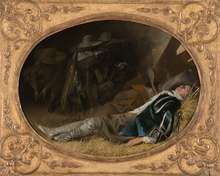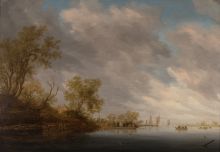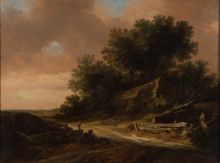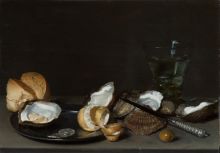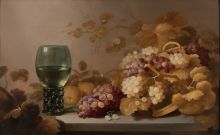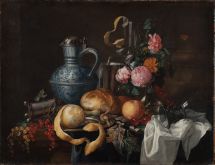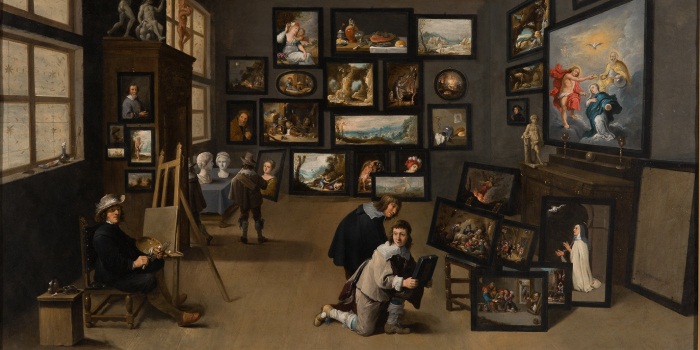
Seventeenth-century dutch painting: The Golden Age
Who doesn’t know the famous Dutch Baroque masters such as Rembrandt and Rubens? Yet in addition to them, the extent and high quality of cultural production in the Golden Age is amazing. Thanks to generous donations from Arnold Otto Aepli and the Albert Koechlin Stiftung, among others, the full diversity of this brilliant age is represented at the Kunstmuseum St. Gallen: religious and mythological subjects by David Teniers (1610–1690) and Moyses van Wtenbrouck (ca. 1600–1646/47), bourgeois genre depictions by Simon Kick (1603–1652) and Pieter Codde (1599–1678), portraits by Jacob Backer (1608–1651) and Salomon Koninck (1609–1656), along with representative landscapes and still lifes.
The Sleeping Soldier by Willem Duyster (1599–1635) is a masterpiece, but even more, it is a true rarity, as only thirty-five paintings by the artist are known throughout the world. Duyster is considered the pioneer of Dutch early-seventeenth-century genre painting, and his works are continually attributed to the renowned Gerard ter Borch. Already in the 1620s, he departed from brightly colored Flemish role models and developed a realistic style with great finesse in the reproduction of materials. In addition to depictions of domestic life, he painted “cortegaardjes,” or “guardroom”: scenes with soldiers at play or resting. Inspired by the war of liberation of the Protestant Dutch against Catholic-Habsburg Spain, these images symbolize the readiness to defend, or like in Sleeping Soldier, the desire for freedom.
The development of the Dutch flat landscape from the Flemish tradition of forest pieces, represented by a work of Gillis Claesz de Hondecoutre (1580-1638), among others, can be comprehended step-by-step based on numerous works by important masters. A rare pair of paintings by Esaias van de Velde (1587–1630) is proof of a new view of reality, which reached its climax in the landscapes by Jan van Goyen (1596–1656) and Salomon van Ruysdael (1600/03–1670). Ruysdael’s River Landscape with Ferry (1641) unites within it, all of the characteristics of this type of painting, such as the diagonal development of the space, and the careful attention in the handling of light and atmosphere. Although «realistic» in details, one must constantly visualize the realization of the painting in the studio. Rather than depicting any particular place, instead, it blends topographical elements to a typical Dutch «ideal landscape.»
Oyster still life, created by an unknown painter, presents a climax of still life painting in the Golden Age. Its historical significance is found in the dating, ca. 1630, whereby the work represents an early stage in the development of the painting genre toward so-called monochrome «banketje.» Although the authorship question has not been conclusively resolved, it is nonetheless undoubtedly one of the genre’s most outstanding examples. The painting therefore illustrates the standard publication on the theme. Bread, a tin plate with cut lemon, oysters, a filled wine glass, an olive, and a knife: despite the unspectacular inventory of objects, the arrangement sophisticatedly presents a perfect painterly realization.
In the unique still life by Roelof Koets (1592–1654) and Pieter Claesz (1597–1660), the symmetrical form of the glasses filled with white wine, with their crystalline clarity offers a clear contrast to the opulence of the overflowing fruit basket and emotion of the foliate plant. The incidence of light concisely depicts the different materials of organic and inorganic matter, of naturally grown and artificially produced. In the precise reproduction of visual phenomena and the reduced coloring, the Still life with Grapes, Apple, and a Roman proves to be a characteristic example of the «monochrome banketje,» a genre of still life, which formed beginning in 1625 in Haarlem in Holland. The painting is dated as 1634, and therefore originates from the heyday of the «monochrome» style. At the same time, it is an example of what was a rather common cooperation in the seventeenth century: The Roman, reproduced with sharp outlines and pastose application of paint, unmistakably reveals the hand of Pieter Claesz, while the soft painting of the grapes, apple, and wicker basket, corresponds with the style of Roelof Koets. The stylistic differences between the two performing hands are not only of art historical interest, but have also found a fortunate aesthetic effect in this picture, which the two painters undoubtedly aspired to. The painting, donated to the Kunstmuseum, represents the «monochrome» still life in a way that is both special and representative, and expands the collection of Dutch still life painting with a further, painterly highlight.
With the limited number of objects and its restrained overall tone, the monochrome style contrasts the later type of resplendent still life heralded in Still life with Flowers and Stoneware Jug (ca. 1650) by Jan Davidsz de Heem (1606–1683/84). The bourgeois desire for representation finds expression in the display of elaborate panels, persistently permeated, however, by thoughts of the transitory, the fleetingness of all earthly existence. Still life painting, in particular, impressively displayed the high artistic quality characterizing Dutch Baroque painting, in general.

